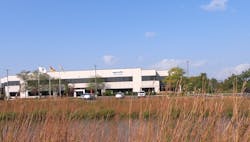Joey Cate was promoted to vice president, Logical Systems (LSI) in January. He’ll work closely with John Bailey, vice president, to provide management and oversight of all LSI North American operations.
For the past 15 years, Cate has been an instrumental part of the team and company growth at LSI, where he began his career in 2006 as an electrical engineer in the Memphis office. In 2008, it was off to the Golden, Colorado, office for three years, where he was a critical part of enabling the rapid growth of that office and played a vital role in the execution of some major transformational projects, including Project Everest, for Golden’s largest customer. After returning to Memphis in 2011, Cate has held roles with ever-increasing responsibility, including branch business manager, assistant branch manager and operations director, all while becoming a licensed professional engineer in 12 states.
“I’ve worked with Joey since he came to Colorado in 2008 to help me start our LSI Golden office, and he’s an exceptional talent and leader that instills loyalty in the hearts and minds of his team,” says LSI President Nick Riggio. “Our employees and customers appreciate his leadership. When the going gets tough, we never wonder where Joey is because he’s front and center, getting things done. He has earned this promotion by having an outstanding work ethic and consistently demonstrating technical, strategic and business acumen.”
Jean-Pierre (JP) Mulley joined OEE Datawatch, an automation system integration company in York, Pennsylvania, as a product expert to support and promote the company’s release of its equipment monitoring and control system, as well as the introduction of several other products.
“JP is a terrific asset to our team because he understands the vision of OEE Datawatch,” says Brian Rajotte, OEE Datawatch president and design engineer. “We both have a long professional history in manufacturing and automation, and we intimately understand the pain of manufacturers and system integrators who want to centralize automation but feel left out of the game because of cost. Together, we’re working to change that thinking and show manufacturers that they can automate without expensive engineering and schematics.”
Before onboarding with OEE, Mulley was an independent consultant, helping clients in manufacturing, IIOT, healthcare and government develop and improve their sales and marketing, product management and data analysis. Prior to consulting, Mulley worked for Minitab, where he served in sales, marketing, product management and professional services and as chief products officer—a position he held for seven years. As a result of his experiences, Mulley has an intimate understanding of the challenges and complexities involved in collecting data that enables meaningful analysis. Mulley earned an economics degree from Carnegie Mellon and holds a Six Sigma Black Belt from the American Society for Quality.
Eric Huston joined GTI Spindle Technology’s leadership team as a vice president and chief operating officer of the GTI Predictive Technology subsidiary to aid in the evolution of the Spindle and Predictive brands. He answered a variety of our questions about the future of the industrial space in light of his new responsibilities.
At GTI Spindle, Huston will drive the development and launch of subscription-based business solutions for machine tool spindle repair enabled through digital transformation. At GTI Predictive, Huston provides leadership and focus encompassing the whole value chain with emphasis on customer excellence, sales, marketing, business and product development.
“Eric’s track record of developing leading-edge solutions while remaining passionate about customer success is paramount to helping us achieve our strategic goals,” says Tom Hoenig, president.
“I am excited to join the leadership team of GTI Spindle Technology as we embark on the development of new go-to-market approaches for machine tool spindle repair business through implementation of servitization, digitalization and outcome-based business models," states Huston.
Earlier in his career, Huston gained extensive experience in industrial aftermarket services and digital transformation in both domestic and international markets. He has an affinity for the influence and contribution of precision maintenance, proactive reliability, energy efficiency and environmental management upon the profitable growth and sustainability of industrial facilities and fleets.
Prior to GTI, Huston held executive positions with increasing responsibility at Schaeffler, SKF and Honeywell (Measurex) after starting his career as a maintenance engineer with International Paper (Champion International).
Huston holds a bachelor’s degree in mechanical engineering from the University of Maine. He is a member of several professional organizations, having served as vice chair of the Manufacturing Technical Group and as chair of the Plant Engineering and Maintenance Division for the American Society of Mechanical Engineers (ASME). He is currently a member of the Best Practices and Benchmarking Committee for the Society of Reliability and Maintenance Professionals (SMRP).
Huston is a certified maintenance and reliability professional (CMRP), and a former certified energy manager (CEM) through the Association of Energy Engineers (AEE).
Joaquin Ocampo and Allen Tubbs are product managers, automation & electrification solutions, at Bosch Rexroth.
What are three key things that a machine builder, system integrator or manufacturer should know about your company?
Joey Cate, vice president, Logical Systems: I believe that three things our customers should know about LSI are the following:
- LSI is a next-gen integrator, meaning that we have a range of in-house capabilities that other integrators do not. We offer electrical design, controls and automation integration and electrical panel fabrication, typical for most system integrators. We also provide manufacturing execution systems (MES) integration, data intelligence services, OT cybersecurity services, full custom process skid, machine design and in-house fabrication, full engineer-procure-construct (EPC) services, construction management and project management.
- LSI is independently owned and is able to offer innovative solutions to our customers that are a best fit for their specific situation, without bias to a particular vendor's platform or solution. We pride ourselves on listening to, learning and understanding our clients' processes and business drivers.
- LSI recently celebrated our 35th anniversary and has grown into an international company with seven offices and world-wide project execution. Our very first customer from 35 years ago is still a customer today.
For system integrators, we’ve standardized much of what is traditionally a customized process. For example, we think schematics are wasteful because they often cause integrators to lose significant money when quoting, and they don’t add value for the customer. Our designs eliminate the need for schematics entirely. With innovations like this, we cut an estimated 30% of the cost out of the traditional, one-off way of designing and quoting control systems, which makes our integrators way more competitive. Now, they can complete twice the number of projects in less time and deliver solutions that are much easier to integrate, operate and maintain.
Our products are designed for manufacturability, meaning that costs are low, quality is high, and turnaround is fast. Again, the old Industry 3.0 way of doing things is too slow, inflexible and expensive. We’re here to free people from restrictive, costly proprietary systems and empower them with automation solutions that are flexible and affordable and that improve their businesses.
Eric Huston, vice president, GTI Spindle; chief operating officer, GTI Predictive: GTI Spindle Technology has been dedicated to fulfilling one specific mission: to provide our clients with the highest quality and most extensive range of machine tool spindle repair services and new spindle applications with unsurpassed customer service.
As part of this mission, the GTI Predictive Technology subsidiary was developed by taking advantage of technological advances to bring the industrial reliability maintenance community powerful, affordable and industry-changing solutions.
Through integration of our general machinery knowledge, and more specifically our in-depth machine tool spindle knowledge, our predictive technologies and repair services, GTI is well-equipped to lead the market development of outcome-based business models in support of customers who are looking for a supplier to take more responsibility and create additional value.
Figure 1: Bosch Rexroth is focused on connectivity, providing a common product platform and offering multiple technology options all under one roof.
With connectivity, for example, we offer the most open connectivity options, with Multi-EtherNet- Sercos, EtherCAT, EtherNet/IP and Profinet. And we support higher level languages, such as C++, Java or Python, to name a few for programming of applications and IoT. In addition, we still provide the ability for using PLC language IEC 61131 for those who prefer that.
We also make it easy for customers by offering a common platform. All the products in our portfolio have the same features across the entire line. So, for example, the same software is used for commissioning, configuration and diagnostics. The safety features are the same, regardless of the hardware. This makes it easier for customers to manage their bill of materials, spares and maintenance.
The last item is our expertise across different technologies. A good example here is our expertise also in hydraulics, where our servo drives act as hydraulic pump motor controllers to improve performance and efficiency. We specialize in linear motion technology, so we’re able to offer preconfigured linear slide systems for easy selection by the users. DC-to-DC converter applications are getting more prevalent in industrial application due to electric vehicle and island grid applications. Our Bosch Rexroth servo system is well adapted to be used as a dc-to-dc converter for nontraditional servo markets. We offer worldwide service and support, including offices in many countries where we provide local support.
Which new technologies are driving your product development and why?
We’re also very focused on safety, and we use technology to create a safer, more stable control systems by design. Many smaller manufacturers worry about OSHA compliance. It’s a burden for them, and it’s difficult to get right, especially within systems that are cobbled together. An example of how we solve this is the separated voltage compartments in our UAK1000 control system. Operators can troubleshoot the system in perfect safety without shutting down the line because the dangerous high-voltage components are completely isolated behind a lockable disconnect.
Allen Tubbs, product manager, automation & electrification solutions, Bosch Rexroth: The digital arena is changing our business in a rapid pace. In fact, the digital shock wave has dramatically changed many industries, overthrown others, and put some of them on the forefront. Opportunities are shifting from hardware to software and services. This is what our new ctrlX Automation platform will provide for the customer or machine builder to be relevant to the times.
CtrlX Automation surmounts the classic boundaries between machine controls, the IT world and the Internet of Things. With a Linux real-time operating system, consistently open standards, app programming technology, web-based engineering and a comprehensive IoT connection, ctrlX Automation reduces components and engineering costs by 30 to 50% while at the same time providing new freedom in engineering.
How does the Industrial Internet of Things figure in your business strategy?
Jean-Pierre Mulley, product expert, OEE Datawatch: It’s a given that manufacturers need to embrace Industry 4.0 and IIOT to stay competitive, so it’s central to our strategy. We see ourselves as the plug-and-play foundation that fits seamlessly within the Industry 4.0 architecture. A lot of companies don't even know where to start, and we have the best way for them to start. Our system provides the bedrock first three layers of the Industry 4.0 architecture —edge/PLC, HMI, SCADA—all in one beautifully integrated and designed box that just plugs into their system. We aim to be the fastest, most cost-effective way to connect IIOT devices to PLC/HMI and SCADA, and we enable small and mid-sized manufacturers to remain competitive by jump-starting their digital transformation and modernizing their manufacturing.
How will machine automation and controls alter the way companies staff their operations in the future?
Allen Tubbs, product manager, automation & electrification solutions, Bosch Rexroth: Machine automation and controls will alter the way companies staff their operations in the future by empowering their staff to do things more efficiently, better and safer. Machine automation and controls will enable the staff to improve operations. For example, by changing between languages on the HMI for operation or changing the ergonomics on the fly for operators running a machine. Other technology, like Bosch Rexroth’s ActiveAssist, can be used for the staff to quickly learn the steps of an assembly process, making the staff a valuable asset for the company. ActiveAssist is revolutionizing the manual workstation and moving the focus of Industry 4.0 towards people. In addition, working with collaboration robots to assist with heavy products or dangerous environment is helping to provide a healthy and safe environment for the staff.
How is the development of software solutions impacting your requirements for hardware?
As engineering and IT continue their convergence, which one is and/or will be leading the direction of future automation and technology at your organization?
Technology that originated in the IT space has slowly gained traction in OT as the benefits to industry overcome the resistance to change. At LSI, we are capitalizing on the convergence of IT and OT to provide improved solutions, and our engineering approach leads the direction of the IT technology integration in our solutions. Looking back over my years in Industrial Automation with LSI, there has been a significant shift in industry to adopt technology like virtualization, managed Ethernet networks for OT, wireless networks for OT, big data and cloud services. New technology can sometimes appear to be a solution looking for a problem to solve, but LSI uses our business-owner mentality and engineering approach to leverage technology to solve automation and business problems.
Looking into the future, how will technology change your company over the next five years?
Our company will be involved in lean manufacturing and the factory of the future with industries able to produce large batches and even down to a batch of one. This will be accomplished by giving the OEM the ability to design configurable machines to be used in the factory floor to have smart movers and robots helping with the logistics of the production and to be able to use additive manufacturing to accomplish such a task. Having the entire factory connected with true transparency for the efficiency of the production.
We will focus on our cross-technology expertise to provide innovative solutions using technology from all our divisions in order for the solutions or products to communicate, work together efficiently and with effortless setup.
In the future, collaboration with different companies will become much easier. It will not be necessary for the users to work with only with one part for their solution. It will be much easier to go to multiple partners for the expertise and integration. Machine builders will be able to choose the experts and they can all work together seamlessly for the benefit of the customer. They can cooperate with the best of all worlds and work together with them. Connectivity and collaboration will be easier thanks to our accessible products and the future of IoT.











